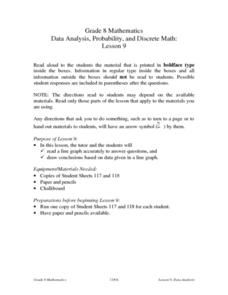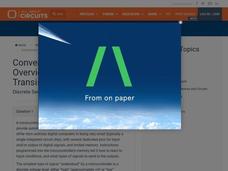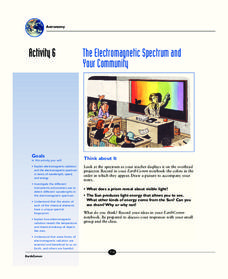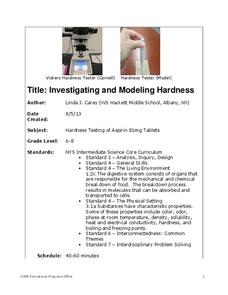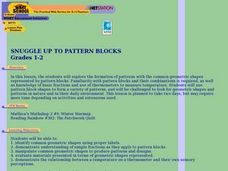Curated OER
Data Analysis, Probability, and Discrete Math: Line Graphs
Eighth graders analyze data from line graphs. They discuss the purpose of line graphs, identify the parts of a line graph, answer questions about various graphs, and complete a worksheet. This lesson includes a script to teach along with.
Curated OER
Weather
Students recognize that carbon dioxide's role in the greenhouse effect. They research the greenhouse effect to design and create a greenhouse structure to measure the changing temperatures over a 24-hour period. In addition, they write a...
Curated OER
Photosynthesis
Students investigate photosynthesis in water plants. In this photosynthesis lesson plan, students use the elodea plant and observe gas bubbles released to determine the rate of photosynthesis. They vary the light intensity and the amount...
Curated OER
Aurora to Magnetosphere Global Exploration
In this magnetosphere global exploration worksheet, students read about the instrument on board a satellite launched by NASA called the Radio Plasma Imager. This imager detects echoes from plasma clouds. Students calculate the distance...
Curated OER
Conventional Transistor Overview and Special Transistors
In this electrical circuit worksheet, students develop an understanding of micro-controllers and then answer a series of 13 open-ended questions about transistors that include analyzing schematics. This worksheet is printable and the...
Curated OER
Vital Signs
Explore the nursing profession! Written for a career exploration unit, this lesson plan gives participants a chance to observe and learn about the skills that a nurse would need. They measure vital signs with appropriate medical...
Curated OER
Warm Me Up!
Third graders explore and identify heat sources. They conduct an experiment involving thermometers and articles of clothing, and record and discuss the results.
Chicago Botanic Garden
Recent Weather Patterns
Decide whether weather is changing! A two-part activity first challenges classes to review the differences between weather and climate. Once finished, individuals then analyze historical data to determine if climate change is happening...
Space Awareness
Seasons Around the World
Why does Earth experience summer, fall, winter, and spring? Using an informative demonstration, learners see how the angle of the sun on Earth and the rotation of Earth determine the seasons. Scholars work in pairs to learn that the...
Workforce Solutions
30 Seconds
Thirty seconds are all scholars have to develop an engaging commercial to showcase their talents and experience within a specific occupation. Pairs work collaboratively to keep each other on time to deliver information speedily and ask...
It's About Time
The Electromagnetic Spectrum and Your Community
Do you have blossoming astronomers who seek to understand the electromagnetic spectrum? Assist them with exploring electromagnetic radiation and the electromagnetic spectrum as the class conducts various activities to demonstrate...
NOAA
Through Robot Eyes
How do robots assist ocean explorers in collecting data and images? The final installment in a five-part series has science scholars examine underwater images collected by robots and identify the organisms shown. Groups then calculate...
Cornell University
Investigating and Modeling Hardness
Model hardness testing with a self-designed hardness test. Young scholars rate the hardness of different types of aspirin using the Vicker's Hardness scale. They then relate hardness to the solubility of each aspirin tablet.
Curated OER
Build a Thermometer
Students build a thermometer. In this weather lesson, students use red food coloring, rubber stoppers, and hard plastic tubing to build a thermometer. Students use their homemade thermometer to measure the temperature.
Curated OER
Hot Friction
Sixth graders use small electronic devices known as thermistors to measure the temperature beneath an object such as a coffee cup as it slides across a surface. By choosing different surfaces, 6th graders can compare in a quantitative...
Curated OER
Carbon Dioxide Heats It Up
Young scholars design an investigation to test whether vegetation in an area helps regulate the ambient air temperature. They make comparisons between the investigation and global changes in climate. In groups, they present their...
Curated OER
Permafrost: Permanently Frozen Ground
Students explore permafrost. In this 3 states of matter lesson, students identify characteristics of solids and liquids. Students observe water and soil melting and freezing at various temperatures. Students make predictions about a...
Curated OER
Snuggle Up To Pattern Blocks
Students view and discuss a video about the use of pattern block shapes to form pictures. They, in groups, form garden and quilt designs using pattern blocks and then decorate the room with their art.
Curated OER
Your Own Fresh Water Aquarium in the Classroom
Learners explore aquariums. In this fish and ecosystems lessons, students establish a freshwater aquarium environment using materials provided. Learners read about and care for the classroom fish.
Curated OER
Jupiter's Weather Forecast
Students read information about Jupiter and the planet's weather. In this Jupiter weather lesson plan, students read information about Jupiter's weather. Students study a chart about the weather on Earth and Jupiter. Students read a...
Curated OER
The Natural World
In this nature worksheet, students complete the sentences about nature by choosing the correct words. Students complete 11 sentences total.
Curated OER
Weather Elements and Instruments
Eighth graders identify the different weather elements. In this earth science lesson, 8th graders explain the difference between relative humidity and dew point. They discuss the different instruments used to predict weather.
Curated OER
Handboiler Lab
Students participate in a handboiler experiment, using a sealed glass vial filled with alcohol. They record the data and do averages and see if there is a difference between a boiler and a non-boiler.
Curated OER
Taking In The Heat
Pupils discover that different textured materials can absorb more heat than others. Students work with thermometers, clocks, and graphs.


